Contested Spaces: Infrastructural Citizenship in the City
 In the weeks after the police killing of Michael Brown in Ferguson, city streets became sites of protest. Residents marched through neighborhood avenues, and rallies closed major intersections. When the tense situation erupted into open clashes between police and protesters, the rights-of-way operated as a conduit of the conflict.
In the weeks after the police killing of Michael Brown in Ferguson, city streets became sites of protest. Residents marched through neighborhood avenues, and rallies closed major intersections. When the tense situation erupted into open clashes between police and protesters, the rights-of-way operated as a conduit of the conflict.
A month after Brown’s death, community organizers announced they would shut down traffic on Interstate 70, one of the most heavily traveled highways in the St. Louis area, by walking onto the roadway. The intent of the protest was to keep attention on Brown’s killing by disrupting commerce and the daily commutes of thousands of regional residents. While protest leaders eventually called off the formal traffic stoppage, dozens of protesters nonetheless attempted to disrupt traffic. Demonstrators trying to enter the roadway were met by a significant police force, which prevented protesters from accessing and blocking the freeway.
The civil disobedience tactic of blocking roadways spread to other cities after a grand jury chose not to indict on criminal charges the officer who shot Brown. In San Diego, Washington, D.C., New York, and elsewhere, protesters blocked highways or major intersections.
Earlier this year, around the one-year anniversary of Brown’s death, dozens of protesters successfully blocked I-70 in St. Louis, achieving what they did not in 2014. During the demonstration a driver forced her vehicle through protesters leading to a brief fight between protesters and the driver. Police broke up the demonstration and arrested more than 50 protesters.
The occupation of public spaces achieves both a political and physical outcome for those engaged in civil disobedience. Similar to those who occupied parks during the Occupy Wall Street protests, blocking a highway allows protesters to claim road space for an unintended purpose and draw attention to their cause. Stopping traffic disrupts the daily life of actors who might otherwise be unaware of or unconnected to the precipitating event and the aims of the protests.
Faced with what they viewed as unjustified police violence and systemic inequality, protesters in Ferguson and elsewhere used the public street to voice their anger and grief. By attempting to control the roadway’s use, even if only briefly, protesters made the roadway a contestable and malleable structure, one that could be defined and used as more than just a traffic artery.
Organized group protests on public streets are not a new phenomenon, nor are law enforcement’s efforts to stop those actions. But the Ferguson highway protests, and similar actions where actors employed infrastructural elements as venues to mediate a larger conflict, are almost completely unique to the post-World War II world.
The reframing of infrastructure as a flexible part of the built environment, as a deployable unit of political rhetoric and civic action, emerged after 1945, when cities across the globe reinvented themselves in the wake of the social, political, and physical changes fomented by the war.
At the same time cities were taking on a new form, once-marginalized populations gained political power and increasingly sought to influence civic decisions, especially in the United States. Never before had a moment of massive urban remaking merged with newly vested citizens interested in seeing their visions for the future implemented.
Among the most salient examples of the meeting of these two pressures in the form of an infrastructural action were civil rights marches that utilized public roadways—such as the Selma to Montgomery march in 1965.
In my recently published article in The Journal of Urban History, I explore these twin developments in greater detail through an analysis of how residents from two Houston neighborhoods responded to highway construction in the 1970s. By politicizing infrastructure, literally making inert materials into arenas in which they could claim and assert political power, the Houstonians I examine – like protesters on the freeway of St. Louis – crafted a shared set of actions that constituted an expression of what I call “infrastructural citizenship.”

Road construction in Courtlandt Place, Houston — or more specifically softening the impacts of that onstruction — demonstrates one aspect of what Kyle Shelton has termed ‘infrastructural citizenship.’
In this case, citizenship was not defined by nationality, but instead by the many acts residents took to construct themselves as political actors.
In 1970s Houston, when confronted by highway construction that threatened to run through or near their homes, residents of the white and wealthy Courtlandt Place neighborhood and the predominately black, mostly lower-class Third Ward used the surrounding infrastructural debates to advocate for the protection of their communities and to forward their own visions for the city.
Concerned that the roads would at worst displace them, or at best lower their property values, residents in both communities staged protests, wrote letters, and attended countless public meetings. They organized historic preservation campaigns, lobbied city officials, and paid for independent planning efforts. They argued that their homes and local streets should be held in the same esteem as regional roadways and downtown redevelopments. With each action, the residents used infrastructural debates to assert their rights as citizens. Even if those efforts failed to achieve their desired outcomes, the simple act of projecting their hopes onto the structures allowed citizens to reshape their meaning on the landscape.
While the Houston examples show that a diverse set of actors embraced infrastructural citizenship, there is no denying that the efficacy of its use depended on differences in political and economic power. In 1970s Houston, black citizens still confronted a racist society explicitly structured to prevent their equality. While they worked to see their interests defended and to see their ideas about the city’s future implemented, they did not possess the political, social, or economic capital needed to affect serious change. White Houstonians from Courtlandt Place, on the other hand, possessed a variety of privileges and connections that enabled them to lessen the impacts of construction.
The spectrum of infrastructural debates that echo the historic Houston examples I highlight, and those from St. Louis’s recent past, show the crucial position that infrastructural citizenship has played in the development of our cities.
Far from secondary debates, struggles over the placement, construction, and use of everything from roadways and major civic projects, to drainage systems and electric lines are among the most hotly contested debates in our cities. Often not given the same media or scholarly coverage as electoral politics or debates about education, infrastructural fights are just essential, if not more fundamental, given the underlying importance of the systems to the operation of the city.
What is crucial about infrastructural citizenship is the universality of its deployment. The concept describes two distinct actions—the use of infrastructure itself to inform a larger debate (voting rights, for example) and the engagement in debates about infrastructure in the hope of directly influencing choices about the systems themselves.
A diverse cross-section of Americans have participated in both forms of infrastructural citizenship. The debates span different historic eras and geographic boundaries. White suburbanites in the 1960s asserted infrastructural citizenship when they advocated for easier highway access to their homes. At the same time, black city dwellers forwarded a different articulation as they resisted the same projects. Comparing different assertions of infrastructural citizenship clarifies how Americans viewed the systems and worked their presence into their lives.
Expressions of infrastructural citizenship, both historic and contemporary, are too often dismissed—whether as the actions of radicals or as NIMBY complaints of an unhappy minority. This view neglects the importance of these fights to the current functioning of our cities and to the decisions we make in the future.
The many infrastructural fights taking place each day cannot be separated from the social and political milieu within which they occur. The protests in Ferguson and the organization against highways in Houston were not solely about control of the roadway. Rather they were wider-ranging debates about race, power, and decision-making in urban America. Protesters, in the 1970s as in the 2010s, turned to the streets and as infrastructural citizens forced those conversation into the public eye.
























































































